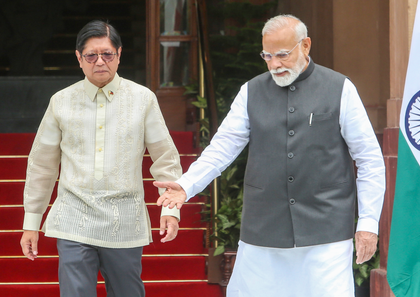India-Philippines strategic partnership and changing dynamics in South China Sea
By IANS | Updated: August 8, 2025 20:45 IST2025-08-08T20:37:49+5:302025-08-08T20:45:04+5:30
New Delhi/Manila: Ferdinand 'Bongbong' Romualdez Marcos Jr., the 17th President of the Philippines, paid a State Visit to India ...

India-Philippines strategic partnership and changing dynamics in South China Sea
New Delhi/Manila: Ferdinand 'Bongbong' Romualdez Marcos Jr., the 17th President of the Philippines, paid a State Visit to India from August 4-8. President Marcos' visit marked the establishment of Strategic Partnership between India and the Philippines while celebrating the 75th anniversary of establishment of diplomatic relations between the two nations. President Marcos was accompanied by 14 ministers, senior officials and a large business delegation during his India visit.
Quite significantly, India and the Philippines Navy conducted joint exercises in South China Sea (SCS) for the first time, during President Marcos's visit to New Delhi.
The synchronization of President Marcos' visit and India's outreach to build partnerships with the Philippines in the South China Sea underscored that India has a stake in securing the region in the context of safety and security of its maritime trade that transits through these waters. The SCS is a strategic shipping route, where about $5 trillion of annual shipborne commerce takes place.
During the visit of President Marcos, India and the Philippines adopted a 2025-2029 Plan of Action under the elevated Strategic Partnership. Both countries agreed to cooperation in several fields, including political, defence, security, maritime, economic, trade, investment, science and technology, etc.
At the bilateral interaction, among other issues, President Marcos expressed interest in deepening defence engagement including purchasing Indian defence equipment. The Philippines being a country of about 7,600 islands follows the archipelagic defence concept to protect its vast maritime territory and resources.
President Marcos announced visa free entry for Indian nationals to the Philippines to encourage tourism and cultural exchange as 2025 is the ASEAN-India Year of Tourism. Prime Minister Narendra Modi emphasised the mutual nature of the agreement and stated that India would allow free e-visas for tourists from the Philippines. Direct air connectivity from Delhi to Manila would commence from October 1, this year.
It is noteworthy that from July 30 to August 4, the Indian Navy and the Philippines Navy were engaged in a joint exercise in the West Philippine Sea.
General Romeo Saturnino Brawner Jr., the 60th Chief of Staff of Philippines Armed Forces (PAF), stated that the idea to hold joint exercises within the Exclusive Economic Zone of the Philippines took shape when he had visited New Delhi in March this year.
According to the Philippines, there is a likelihood that a minor confusion in the SCS could lead to a full-blown war with China any time.
The PAF is happy to engage with the Indian Armed Forces having similar values. The PAF is satisfied with the Indo-Russian BrahMos supersonic cruise missile system to bolster its coastal defence capabilities amidst escalating tensions with China and wants to secure more weapons from India for army and navy including joint collaboration.
China claims nearly the entire SCS, overlapping with maritime zones of Brunei, Indonesia, Malaysia, the Philippines and Vietnam. Separately, a July 2016 ruling of an international arbitral tribunal under Annex VII of the United Nations Convention on the Law of the Sea (UNCLOS) found no basis of Beijing's sweeping claims under international law and ruled in favour of the Philippines against China. China has rejected the decision. The ruling was considered a milestone in the legal framework for resolving maritime disputes under UNCLOS.
India's perspectives on the SCS disputes are evolving, moving from a cautious neutrality to a more proactive and nuanced approach driven by its Act East policy and Indo-Pacific vision. India views the SCS as part of the global commons and supports freedom of navigation and overflight in the region and legitimate commerce through the waters of SCS. The region has been an important Sea-Lanes of Communication (SLOC) for more than 1,500 years. Indian traders have sailed these waters and there is archaeological and historical evidence of the presence of Indian traders in this passage. Undisputedly, SCS will always remain in India's maritime compass and in the S-band radar.
While not a claimant state, India has a vested interest in the SCS due to its significant trade route. India is ramping up its involvement in the South China Sea. As a leading maritime power in the region, India is concerned about the developments in the SCS, which has created dissensions among ASEAN countries over the territorial claims of some of the islands leading to a greater friction. ASEAN-China relations are under stress and India is trying to fill up the void as a responsible maritime power to stabilise the situation.
Approximately 55 per cent of India's trade passes through the SCS and the Malacca Strait. This makes the region a crucial waterway for India's trade with the Indo-Pacific and beyond. In New Delhi's strategic calculus, deployment of the Indian Navy in these turbulent waters of SCS has put China in a difficult position with India and the Philippines both being sovereign nations. Importantly, the growing engagement between New Delhi and Manila is indicative of India emerging as a reliable strategic partner of the Philippines.
(The writer is an expert on South Asia and Eurasia. He was formerly with Manohar Parrikar Institute for Defence Studies and Analyses. Views expressed are personal)
Disclaimer: This post has been auto-published from an agency feed without any modifications to the text and has not been reviewed by an editor
Open in app